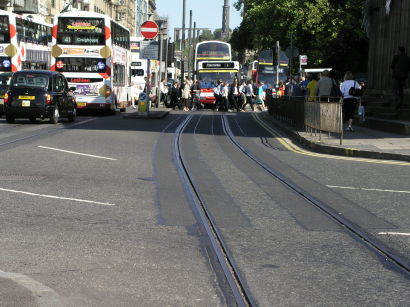SECRET discussions have been under way in a bid to save Edinburgh’s floundering tram project. With work at a virtual standstill and costs still rising, the developers and their contractors have been locked in mediation talks.
The gleaming trams are marooned in their new depot, while some of the Scottish capital’s major thoroughfares are threaded with empty tramlines. Some of them, ironically, have already been deteriorating under the impact of conventional rubber-tyred vehicles while the bitter contractual disputes between contractor Bilfinger Berger and the council-owned development company TIE have rumbled on.
Few people now believe that even part of the planned Line One – between Edinburgh Airport and the city centre – can be completed for the last officially-calculated budget of £545 million.
This was agreed after the last parliamentary election, when the SNP scrambled into power in May 2007 on a minority vote and only reluctantly agreed to find a core £500 million for the scheme after Green Party MSPs – whose support was essential to give the SNP any real power in the chamber – refused to let the vision of Edinburgh trams die.
But Edinburgh City Council, which is reintroducing trams after more than half a century, must find the rest of the money, however much this proves to be.
There seems to be little likelihood that trams will be carrying passengers through Edinburgh in the next two years – the most optimistic predictions are now speaking of mid-2013.
Even then, parts of the first line will be probably incomplete, leaving Newhaven and Leith licking its wounds after tolerating the disruption of construction without the compensation of gaining what should have been a state-of-the-art public transport link.
Other citizens have also been outraged by the failure to complete the scheme, to judge by the letters of protests on websites and in Scottish newspapers.
Audit Scotland warned TIE recently that public confidence in the project was very low, but officially the section to Leith is still live, with a review of the scheme now under way.
TIE said in December: ‘The planned review on future governance will still be undertaken over the next year and no decisions have yet been made. The plan has always been for trams and Lothian Buses to operate an integrated service and this remains the case.’
While the talks continue behind closed doors and the review is prepared for TIE, the politicians must steel themselves for possible fallout within a couple of months, because the problems threaten to be a key issue at this May’s parliamentary election.
Four years ago, when the last elections were held, the scheme’s supporters must have been hoping that at least some of Edinburgh’s electors could have been hopping on a tram to the polling station in 2011. Now they’ll have to drive, take a bus – or walk.


